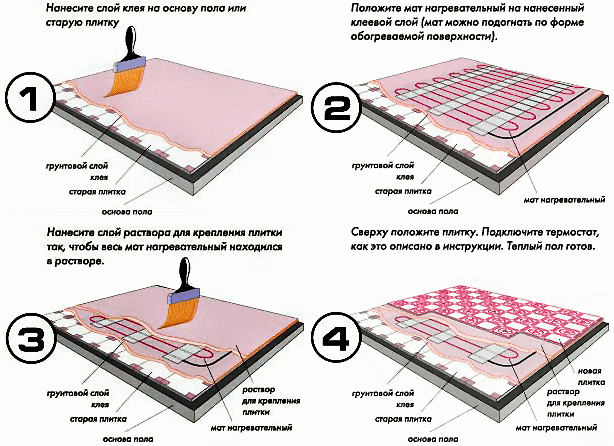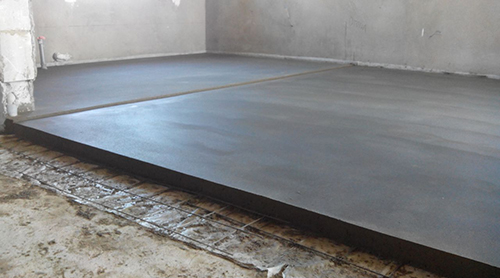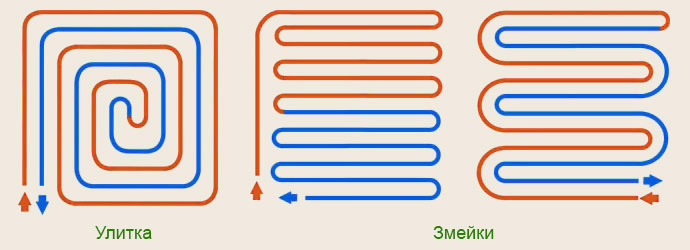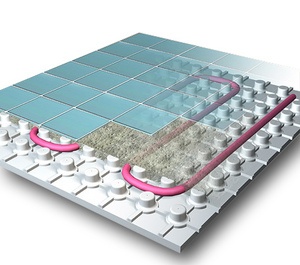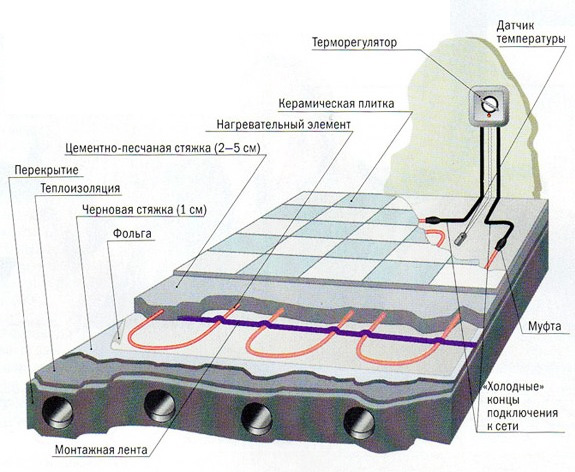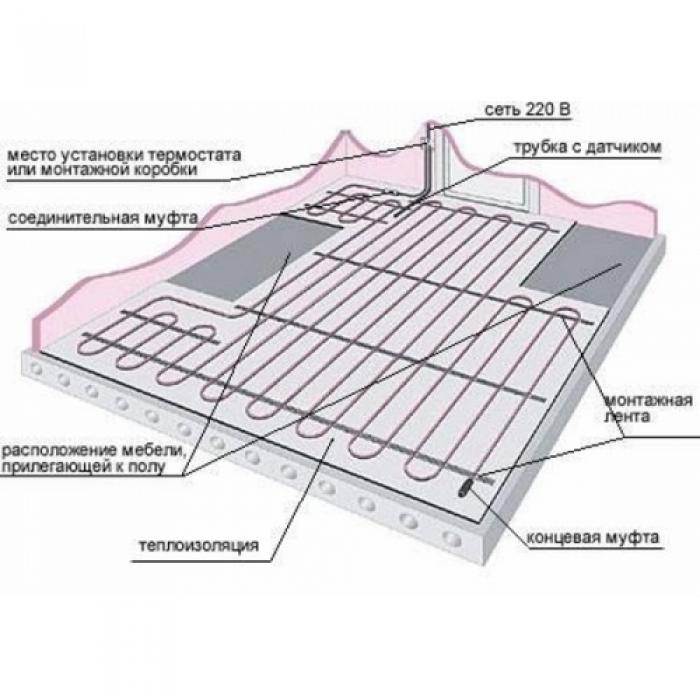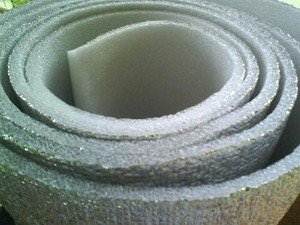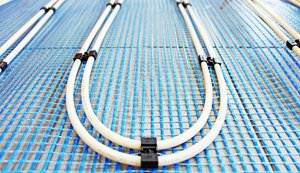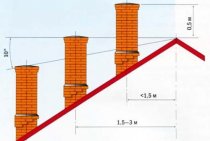The choice of insulation
If you plan to make a storage room here that will not be particularly warm, you can get by with formal insulation, and if you plan to install additional heating and it should be warm in the winter season, you will have to look for a solution with maximum efficiency. There are several materials that can help to cope with the task:
- Styrofoam or foam plastic are practically "brothers" and differ in their characteristics in terms of service life, resistance to moisture and sunlight. They are used when you need to seriously insulate.
- Mineral or stone wool are excellent heat saving indicators and are easy to work with. However, you will need to create insulation from water. The cost will be higher than other options.
- Izolon is all-foam polyethylene, usually having one foil side. The same case of "formal" insulation.
Other materials, like expanded clay, cannot be used here - you need a too thick layer. The effective work of expanded clay for heat saving will start from a backfill thickness of twenty centimeters.
Installation of electric underfloor heating under tiles
Of the several options for electric underfloor heating (cable, film or heating mats), the most acceptable for tiles is a warm floor, where heating mats act as a heat carrier.
The mats are made in the form of a fiberglass mesh with shielded heating sections attached to it. Sections are obtained by joining the cold and hot parts using a jointless method. This determines their reliability.
The first step is to draw up a detailed layout of the heating mats. It is worth noting that in places where furniture will subsequently be placed, heating elements should not be placed, they can quickly fail.
Serial installation of heating mats
All debris and dust must be removed from the floor surface. If necessary, the floors are leveled. Additional thermal insulation materials are laid out on the surface to prevent possible heat loss. In the future, such a measure will significantly increase the feeling of comfort.
An important stage is the creation of a high-quality cement screed. It is she who will become a reliable basis for the subsequent installation of ceramic tiles. How to do this, read this article.
The screed should be as even as possible.
Heating mats are laid exactly according to the scheme drawn up in advance. After this is done, the system is connected to the electrical network. Having finished with the connection, we install the temperature controller.
You will also need to install a special temperature sensor and an emergency shutdown device.
You need to check the functionality of the system. For this, electrical wires are connected to the network. If any problems arise, then their elimination should occur at this stage. Otherwise, you will have to dismantle the floor.
Ceramic (if chosen) tiles should be laid directly on the mats using the normal laying method using standard tile adhesive.
In this case, the thickness of the adhesive layer should not exceed 7 millimeters. The floor can be turned on only after three weeks, when the glue is completely dry.
Types of insulation and necessary tools
The advantages of an insulated floor are quite obvious. First of all, the legs will always be warm, which will not lead to a runny nose. The uniform distribution of warm air throughout the room will help to avoid drafts in it. You can approach the floor heating process in different ways.
These include:
- electric floor heating;
- heating with water;
- insulation with insulating materials (mineral wool, glass, basalt fiber, etc.).
The scheme of laying pipes for underfloor heating.
In order to engage in the process of repairing floors, it is necessary to prepare for this matter. To do this, you will need the following tools and materials:
- a puncher that will be needed to remove old tiles and prepare the coating;
- a mixer or mixer with a nozzle for a perforator cartridge for preparing a solution for a screed;
- building level to determine the horizon of the floor;
- voltmeter or tester, which will be needed to check electrical connections;
- polypropylene pipe with scissors, a soldering iron and the necessary accessories for the preparation of water heating;
- reinforcing mesh for preparing the screed.
Pipe placement rules
When placing the pipes of the underfloor heating system, it is necessary to ensure that they do not twist or break, otherwise the system will leak and will have to be dismantled.
On top of the penoplex, you can put a moisture-resistant outdoor USB. A centimeter layer of tile adhesive is applied to it, partially removed with a comb spatula and immediately proceed to laying tiles. If there is no balcony or loggia below, then you should think about building a frame from wooden bars, in the cells of which mineral wool or other insulation is placed. It is covered with foil material for thermal insulation, reinforced, and a rough screed is poured.
Now spread the substrate and lay the tubes of the system. On top of these tubes, a screed no more than three centimeters thick is poured again, and tiles are already being laid on it. It is worth checking the operation of the structure that provides heating on the balcony before pouring the top layer of the screed.
What type of modern underfloor heating should you choose?
The underfloor heating system on the balcony or in any other room is a design of heating elements.
Their role can be played by metal-plastic pipes through which the coolant passes, or heating electrical elements.
That is, the warm floor on the balcony can be:
- water;
- electric (film, cable or heating mats).
Water heated floors on the balcony are able to heat the floor as evenly as possible over the entire area.
Water perfectly save space, and operating costs will be lower than for electric floors, since water as a heat carrier is much cheaper.
But in water warm floors have their drawbacks, for example, the difficulty in adjusting the temperature regime, a possible periodic decrease in pressure inside the riser.
In the event of a leak, it will be difficult to find and even more difficult to eliminate. We must not forget about the complexity of installation and the rather high cost of construction.
As for electric underfloor heating on the balcony, they have almost the same advantages as water ones. But in terms of the totality of all operational characteristics, the electric underfloor heating is far ahead of the competitor.
In addition, the electric underfloor heating provides uniform heating of the entire area.
Finding a malfunction and eliminating it is much easier than in the case of a water floor. Installation is very convenient to carry out in the limited space of the balcony of a typical apartment in a multi-storey building without special equipment. And the cost of such floors is much lower. Among the shortcomings, only one - bills for electricity consumption.
With the help of an electric floor, you can easily control the temperature.
Weighing all the pros and cons, it is easy to make a choice in favor of an electric underfloor heating for installation on a balcony.
Instructions for floor insulation on the balcony
Balcony floor insulation using heat-insulating material
Do-it-yourself insulation of the balcony floor with a heater can be done as follows:
- Thoroughly clean the floor surface from the old finish (if any) and debris using a regular broom or vacuum cleaner.
- The floor is then waterproofed.laying a special film, but penofol is better, which simultaneously serves as the first layer of insulation. It is laid over the entire surface, if necessary, cutting the material with a knife to give the desired shape. When laying, it is better to use whole pieces of penofol in order to avoid a large number of joints.
- Having finished laying the penofol, the balcony is treated with mounting foam around the perimeter of the floor. blowing out the joints and seams of the material.
If you want to visualize how to properly insulate the floor on the balcony, you should find a thematic one on the net.
Balcony floor insulation
- Next, wooden beams with a section of 50 * 50 mm are laid and fixed on top of the foam foam layer. The bars are laid transversely in increments of about 50 cm. The extreme bars are mounted with an indent from the walls of 5-10 cm. Before the floor is insulated on the balcony, the bars are fastened with several self-tapping screws (at least 4x).
- Then the openings between the bars are filled with 50 mm thick foam boards. When laying the slabs, they should be flush with the upper surface of the bars. The insulation is introduced as tightly as possible into the openings between the bars, thereby reducing the number and size of cracks. If gaps cannot be avoided, voids should be filled with mounting foam.
- Next, a grooved board or chipboard and waterproofing are laid on the floor. if it is planned to lay ceramic tiles.
Balcony floor insulation with underfloor heating system
Now let's take a step-by-step look at how to insulate the balcony floor with a system of underfloor heating:
- Styrodur insulation boards 20-40 mm thick are attached to the concrete base of the balcony with a special adhesive.
- A thin layer of the same glue is applied over the insulation and a special welded metal mesh is placed on it.
- Underfloor heating cables are laid by means of a metal mounting tape, which ensures that the cable pitch is constant. The step should be 10 cm.
- The tape is laid out over the grid and attached to the base with self-tapping screws. The distance between the two tapes is provided at least half a meter.
Floor insulation on the balcony must be carried out in strict accordance with the instructions supplied by one or another manufacturer of cable heating structures.
Scheme of the electric floor heating device on the balcony
- In the gap between the cable branches, a temperature sensor is placed, enclosed in a corrugation. The ends of the cable are led to the thermostat, and the temperature sensor is also connected there.
- A 4-5 cm thick screed is poured over the cable system.
The operation of the cable can only be started after the screed has completely hardened. If the screed solution was made from a dry mix, the curing time should certainly be indicated on its packaging.
In addition, when choosing a facing material for a balcony floor, it is recommended to give preference to materials (including tile adhesive) suitable for laying on a warm floor system according to their instructions.
A good solution for insulating the floor on the balcony can also be the use of the so-called thin warm floor. Laying such a warm floor under the tiles on the balcony is very simple: thin mats of this system have a self-adhesive base, which greatly facilitates installation.
Also, a thin warm floor does not require a screed device and can be arranged, for example, in a layer of tile adhesive.
As you can see, insulating the floor on the balcony is not as difficult as it might seem at first glance. It is only necessary to treat the task with diligence and strictly follow the instructions.
More information on the topic: http://obalkonah.ru
Features of insulation work and benefits
There are several options for the device frame:
- from wooden logs,
- from filling with dry heat-insulating compounds and concreting,
- from concrete with insulation.
But in order to ensure the rigidity of the floor and to exclude subsidence and dips in the thermal insulation composition over the entire distance of the floor, it is advisable to use an additional bar frame set to a level and to a certain height, taking into account subsequent decoration.
The frame not only provides a level, but also makes it easy to place insulation materials between the joists.
For the installation of wooden logs, either a wide board is used, with a small thickness of the insulating material, or a wooden beam with mounting stands made of metal, pieces of the beam.
A wooden frame made of timber, laid with a distance of half a meter, will perform a beacon level. The supports must be securely fastened to the floor of the balcony slab and to the beam frame.
After checking the level and reliability of the frame, it is possible to insulate the loggia with materials and finish the floor.
How to insulate a balcony floor
The first step is to figure out how to insulate the floor on the balcony.
This can be done using two means:
- by laying insulating material (passive insulation);
- through the device of the "warm floor" system on the balcony (active insulation).
Consider the features of each of the presented methods of insulation.
How to choose the best insulation
Floor insulation on the balcony, as a rule, is performed using the following types of heaters:
Penofol. This thermal insulation material is made of polyethylene foam and aluminum foil. It has proven itself both as a high-quality insulation and as a means for sound and waterproofing. Penofol is produced with foil on one and both sides in rolls. The thickness of the material can be 3, 5 and 10 mm. Insulation with penofol involves the sharing of material with penoplex.
It looks like a foam roll
- Styrofoam has been used in construction to insulate balconies for a long time due to the combination of insulating qualities and low cost. Styrofoam is produced in sheets from 2 to 10 cm thick. Insulation of floors on a balcony with foam plastic is usually carried out in the form of laying it between wooden logs, followed by flooring on a wooden base.
- Foamed polystyrene foam or penoplex has very high thermal insulation properties. Among other advantages, penoplex has low vapor permeability, chemical inertness, ease of installation, but is somewhat more expensive than alternative options. Penoplex sheets are 2-5 cm thick. Penoplex is a good option for insulating balconies.
- Mineral wool. It is also a very common building insulation, made on the basis of basalt or fiberglass and resembling ordinary medical wool in structure. Such a floor insulation on a balcony will perfectly retain heat and can be laid even in small cracks. Mineral wool is produced in sheets and rolls of various thicknesses.
Insulation with underfloor heating system
Another more than relevant solution is laying underfloor heating on the balcony. The system can be a structure made of electric heating cables or metal-plastic pipes with water heating.
For a balcony, in most cases it is rational to use the construction of the first type, since a water-heated floor is difficult to install and is beneficial only when insulating large areas.
Water heated floor for a balcony
Before insulating the floors on the balcony, you will need to choose a suitable electrical system. When choosing a system of underfloor heating for a balcony, it is necessary to build on its power, which should be about 150 W / sq.m.
